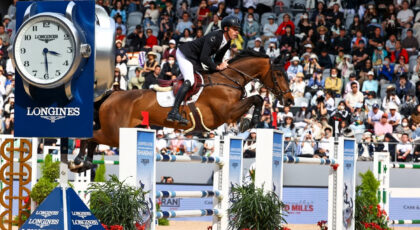The human prefrontal cortex loves progress.
Forward, forward, forward. Set the goal and move inexorably toward it.
Sometimes you can’t go as far forward as you’d like in one leap, but even a little forward movement is better than none. Or is it?
In training a young horse, it’s important to know when to stop and take a step back. I did that with my young Warmblood True a few months ago, and it has created all sorts of positive results. Now we are moving forward again, but with greater trust, a more solid understanding, and much calmer mindsets.
True and I generally work in one of two arenas.
Arena A is much larger and busier, close to the hubbub of the barn and parking area, with trees and bushes on two sides. Because the ranch sits on a hillside, Arena A is also raised on two sides about 15 feet above the surface of a relatively busy driveway.
The footing is great in Arena A, and size allows me to work True on long straight lines, big circles, over small jumps, and past a lot of new sights and sounds.
The only trouble is that he is constantly distracted by all the activity there—lessons, cars, dogs, loud talk, barn repairs, trees waving in the wind, tractors, ATVs, hay loading, people coming and going. He is also concerned by his position above fast-moving cars on the driveway. This distraction was compounded by fear when I made the big mistake of continuing to ride True in Arena A while a new barn employee weed-whacked all the way around it.
Arena B is much smaller but on a more shallow hill, so that people, horses, and cars are at about the same level as True is while we are working. It gets very little activity and is located far from the barn.
The wind is stronger there, and it offers little more than an oval large enough to canter. The other horses I ride are often distracted in this arena by the increased wind, its distance from other horses at the barn, and the fact that it is bordered by horses occasionally dashing around a 50-acre pasture.
But True is different—he’s always been calmer in Arena B.
For the first two years of True’s training, I used Arena A most often. I felt it was important for True to get accustomed to the greater activity there. (That belief led to my mistake with the weed whacker. Duh.) So we fought through all the distractions, day after day.
Previous articles in this column describe True’s terror of livestock. In addition to the everyday commotion described above, from Arena A True and I negotiated a herd of cattle next door on a daily basis, and a flock of gigantic Navajo sheep on one very memorable occasion that sent me to the Emergency Room.
I’m embarrassed to say that it took me a long time to get over the “forward progress” mentality despite my occupation as a human and equine brain scientist who writes about indirect training. Three or four months ago, I reconsidered.
Over time, True was becoming more sensitized—not less—to Arena A’s hazards. In fact, so was I, and we all know that tension transmits just as well from rider to horse as from horse to rider.
The two of us spent most of our training time learning about wind. And cattle. Dogs and cars. Those damnable sheep. Children squealing and adults shouting. Most trainers would say these are necessary lessons that will eventually de-sensitize the horse, and that to change arenas would be the wrong thing to do.
But I listened to my horse and to my own feelings of tension in Arena A.
I took a giant training step backward and moved our sessions to Arena B. True immediately settled down. Now able to focus on me every day, he has learned more in three months of Arena B than he did in a year of Arena A.
As he progresses, I occasionally cool him out at the end of our sessions by walking in Arena A on a loose rein when no one is using it. Just to show him it can be a nice relaxing place. He is no longer frightened there.
Little by little, I’ll re-introduce him to Arena A and ratchet up his level of exposure to activity there. He’s ready for it now. One backward step made all the difference.
On the outside, we might look the same. But inside True’s mind, a lot has changed.
Related reading:
- “Don’t Think About It”—Yeah, Right
- Sharing the Arena
- The Perfect Flying Change
- Health Care for the Young Horse
Janet Jones will present “Brain to Brain: Cross-Species Communication between Horses and Riders” at the World Equestrian Center in Ocala, Florida, on March 14, 2024. Come to the talk and enjoy the international Winter Spectacular Hunter/Jumper Horse Show too. Learn more and reserve your tickets at https://janet-jones.com/product/janet-jones-ticket-sales.

A version of this story originally appeared on janet-jones.com. It is reprinted here with permission.


 February 28, 2024
February 28, 2024 


























